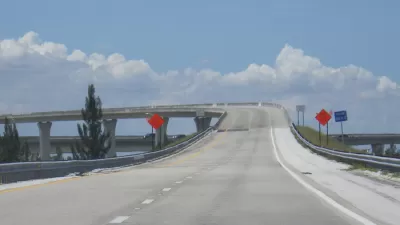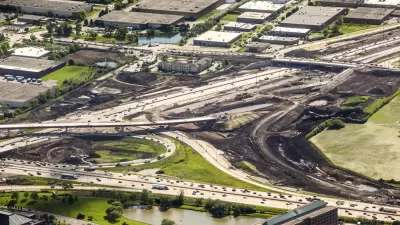Critics worry the proposed 330-mile corridor would encourage sprawl, harm wildlife, and saddle the state with decades of debt.

A proposed highway project in Florida, the Multi-use Corridors of Regional Economic Significance program, or M-CORES, has met with strong resistance from "a diverse cross section of opponents" who have called the proposed highways "roads to ruin."
Despite hopes that the three proposed highways "will help the state keep up with its explosive population growth," Eric Tegenhoff writes in a piece for Grist that groups from conservationists to taxpayer watchdogs have expressed concern about the project's cost and potential disruptions to wildlife habitats and rural economies.
The 330-mile toll road corridor could cost as much as $26 billion and, if completed, is projected to open by 2030. "In a year when lawmakers must reckon with the pandemic’s budget impact, the price tag for M-CORES is difficult for some critics to swallow." Meanwhile, environmental groups argue that new roads will just bring more traffic, encourage sprawl, and "disturb some of the state’s natural barriers against sea level rise, such as wetlands."
According to the Florida Department of Transportation (FDOT), the agency "will conduct financial and environmental feasibility studies when the agency chooses the most suitable path." In a statement sent to Grist, agency spokesperson Natalie McElwee wrote "A 'no-build' option remains on the table." An analysis by an opposition coalition calling itself No Roads to Ruin found that 93 percent of public comments sent to FDOT about the project were negative, "suggesting that there is little constituency for M-CORES."
FULL STORY: Basically everyone in Florida is united against these new highways

Alabama: Trump Terminates Settlements for Black Communities Harmed By Raw Sewage
Trump deemed the landmark civil rights agreement “illegal DEI and environmental justice policy.”

Planetizen Federal Action Tracker
A weekly monitor of how Trump’s orders and actions are impacting planners and planning in America.

Why Should We Subsidize Public Transportation?
Many public transit agencies face financial stress due to rising costs, declining fare revenue, and declining subsidies. Transit advocates must provide a strong business case for increasing public transit funding.

Judge Orders Release of Frozen IRA, IIJA Funding
The decision is a victory for environmental groups who charged that freezing funds for critical infrastructure and disaster response programs caused “real and irreparable harm” to communities.

‘Clybourne Park’ Sets Stage for Housing Equity Discussions
Clybourne Park, a play exploring race, real estate, and community tensions, can set the stage for discussion on the lasting impacts of housing discrimination, gentrification, and the fight for affordability.

Understanding Road Diets
An explainer from Momentum highlights the advantages of reducing vehicle lanes in favor of more bike, transit, and pedestrian infrastructure.
Urban Design for Planners 1: Software Tools
This six-course series explores essential urban design concepts using open source software and equips planners with the tools they need to participate fully in the urban design process.
Planning for Universal Design
Learn the tools for implementing Universal Design in planning regulations.
Caltrans
Smith Gee Studio
Institute for Housing and Urban Development Studies (IHS)
City of Grandview
Harvard GSD Executive Education
Toledo-Lucas County Plan Commissions
Salt Lake City
NYU Wagner Graduate School of Public Service





























